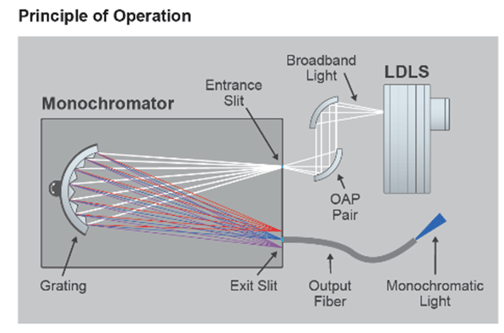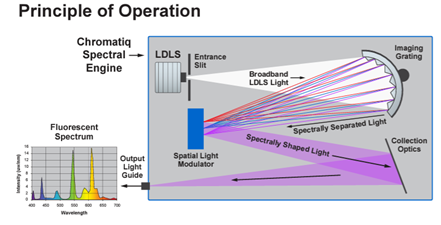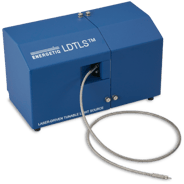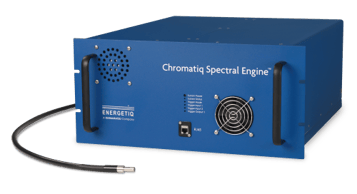Hit the Right Wavelength with the Right High Brightness Light Source: Comparing LDTLS and CSE Light Sources
Selecting the correct light source for your needs is important. While you may know what wavelength you need, it takes the proper equipment to get you there. Our Laser-Driven Tunable Light Source (LDTLS®) and Chromatiq Spectral Engine™ (CSE) systems are two of our most versatile and powerful light sources, giving you the tools you need to meet your goals. The light source you choose ultimately depends on your application.
Factors that might influence your light source choice include:
- brightness, spot size, and power requirements
- price and cost of ownership
- wavelength requirements – does your application need broadband light or a smaller range?
- uncertainty about which wavelength range will be optimal
So, which light source is right for you? We’ll break down the differences. But first, let’s understand the technology behind each source.
Laser-Driven Light Sources
Before comparing the LDTLS and CSE systems, it’s important to understand the core technology—the LDLS—that drives system performance.
High spectral radiance is the hallmark of the LDLS, where extremely small, high-brightness plasma delivers efficient light collection and a broad spectral range from the deepest UV through visible and into the NIR. LDLS provides the LDTLS with its high light output in a narrow band. For the CSE, the combination of award-winning optical design and the LDLS provides the high radiance and stability that drives the systems’ high-fidelity spectrum matching, rapid switching between spectra, and stable color content at varying intensities.
Laser-Driven Tunable Light Source
LDTLS systems offer high light output in a narrow band, perfect for those looking for a specific monochromatic output. Unlike setups with an external monochromator, the LDTLS’s fully integrated monochromator is designed for maximum performance with no room for variables that arise from different sources. The LDTLS provides access to a wide wavelength range of tunability, high spectral resolution, and an extremely long life with the convenience of a fiber-coupled output.
Understanding the LDTLS Monochromator
A monochromator is an optical device used to select a single wavelength of light from a broadband source. It does this by breaking the light up into its component colors and selecting a single color using a series of mirrors or prisms.
Monochromators are used in a variety of applications, such as spectroscopy and laser physics. In spectroscopy, monochromators isolate specific wavelengths of light so that they can be studied in detail. In laser physics, monochromators control the wavelength of lasers so that they can be tuned to the desired frequency.
|
What sets Energetiq light sources apart from the competition? LDLS and expert optical design, and light output types (TLS - fiber optic cable, CSE - liquid light guide)
|
How the LDTLS Works
 A monochromator sits inside the LDTLS, along with one of Energetiq’s laser-driven light sources. The monochromator splits incoming white light from the light source into different wavelengths. Within the monochromator, a diffraction grating splits the wavelengths into several beams traveling in different directions.
A monochromator sits inside the LDTLS, along with one of Energetiq’s laser-driven light sources. The monochromator splits incoming white light from the light source into different wavelengths. Within the monochromator, a diffraction grating splits the wavelengths into several beams traveling in different directions.
The Importance of the Diffraction Grating
A diffraction grating is an optical component with a regular pattern of thin, parallel slits that diffract light into a spectrum. The grating can be observed as a series of dark and light bands on a screen when illuminated by white light. The distance between the maxima of the bands (the fringe spacing) is inversely proportional to the wavelength of the light.
When white light shines on a diffraction grating, each color is bent by a different amount because each color has a different wavelength. The amount of bending depends on the angle between the incident light and the grating, with steeper angles resulting in more bending. As a result, each color is sent in a different direction, resulting in the formation of a spectrum on a screen. The number of lines per millimeter (l/mm) or the number of fringes that are visible in a given band also affects the width of the spectral lines. A higher l/mm means narrower lines, while a lower l/mm results in wider lines.
Different materials can be used to create diffraction gratings, including glass, quartz, and plastic. In addition, gratings can be either transmissive or reflective. Transmissive gratings are used for applications such as spectroscopy and eye-safety lasers, while reflective gratings and lasers are used in data storage and optometry instruments.
All diffraction gratings have an inherent efficiency that limits the amount of light that can be transmitted or reflected. The efficiency is determined by both the material used to create the grating as well as the l/mm. When selecting a diffraction grating for an application, it is important to consider both factors to ensure optimal performance.
Chromatiq Spectral Engine
Understanding the CSE’s Digital Micromirror Devices
A digital micromirror device (DMD) is an optical assembly consisting of highly reflective, microscopic mirrors. The mirrors can be individually rotated to an “on” or “off” state where the pixel can be displayed brightly on the screen or elsewhere. DMDs are often used in applications such as:
- televisions
- head-mounted displays
- digital cinema
- optical metrology
- laser beam machining
DMDs give systems incredible degrees of tunability.
How the CSE Works
The CSE takes tuning to another level. In addition to a monochromator grating, the CSE also uses a DMD to allow for wavelength and amplitude selection, giving users access to virtually any visible spectrum.

Comparing CSE and LDTLS Light Sources
While the CSE and LDTLS have many similarities, it’s important to understand their distinguishing features. In short, the TLS is a monochromator-based system that provides narrow wavelength band output while the CSE uses DMD to match broadband spectra with high fidelity.
The LDTLS has a limited ability to match spectrums, however, it operates at a higher brightness. Additionally, the liquid light guide output of the CSE has a larger diameter than the LDTLS fibers, meaning that you can’t focus on as small of a spot using the CSE. Take a deeper look at each system:
|
LDTLS for Precise Measuring |
CSE for High-Fidelity Spectrum Matching |
|
| Summary |
|
|
| Wavelength | 200 nm – 1700 nm* | 380 nm – 780 nm** |
| Spectral Resolution | 6.0 nm | < 4.5 nm |
| Scan Speed | < 20 ms per 2 nm step | < 10 ms |
| Numerical Aperture (1.5 mm Output fiber) |
.39 NA | - |
| Output Type |
Fiber Optic Cable (1.5 mm) | Liquid Light Guide (6.5 mm) |
| Wavelength Selection |
Monochromator | DMD |
| Applications |
Best for MEASURING Sensor Calibration CMOS Image Sensor Testing Ambient Light Sensor Calibration Virus and Bacteria Deactivation Proximity Sensor Testing Fluorescence Test of Phosphors |
Best for MATCHING Ambient Light Sensor Test & Calibration Cameras/Image Sensors/CMOS Colorimetry Instrument Calibration Spectroscopy Light Sources Generate Custom Spectrum Image Sensor Development |
| Resources |
Which LDTLS suits your project?Download the LDTLSSelection Guide |
Curious about the CSE?Download the Chromatiq Spectral Engine |
*Wavelength range dependent on model
**Future models will have an expanded range
LDTLS systems let you break free from wavelength constraints for quick, repeatable, and precise measurements across the broadest spectrum. CSE systems make use of their DMD to create versatile wavelength and amplitude selections. Whatever your application, Energetiq strives to bring you only the best. Learn more about our capabilities.





